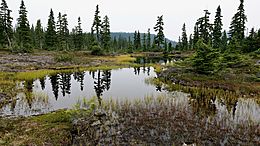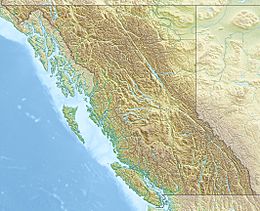Forbidden Plateau facts for kids
Quick facts for kids Forbidden Plateau |
|
|---|---|

One of the many lakes of the Forbidden Plateau
|
|
| Location | British Columbia, Canada |
| Coordinates | 49°41′00″N 125°19′00″W / 49.68333°N 125.31667°W |
| Part of | Vancouver Island Ranges |
| Geology | Plateau |
The Forbidden Plateau is a small, hilly area located on Vancouver Island in British Columbia, Canada. It's part of the Vancouver Island Ranges and sits between two mountains: Mount Albert Edward and Mount Washington. This plateau is known for its beautiful natural scenery.
Contents
Exploring the Forbidden Plateau
The Forbidden Plateau has gentle slopes and small, rugged hills. It is dotted with many small lakes. Much of this area is inside Strathcona Provincial Park.
There are many trails for people to use. These trails are great for hiking and cross-country skiing. They also provide access to Mount Albert Edward.
Unique Plants of the Plateau
On Mount Becher, which is in the southwest part of the plateau, there's a special meadow. This meadow is one of the few places in Canada where you can find the Olympic onion. This unique plant is also known as Allium crenulatum.
Earthquakes and Geology
The Forbidden Plateau was the center, or epicentre, of a very strong earthquake. This earthquake happened in 1946 and is known as the 1946 Vancouver Island earthquake. It measured 7.3 on the Richter magnitude scale. This was the strongest earthquake ever recorded on land in Canada.
The Legend of the Forbidden Plateau
There is a popular story about the Forbidden Plateau. This legend says that the K'omoks people used to take their women and children to the plateau. They did this to keep them safe during raids from other tribes.
One day, during a raid by the Cowichan tribe, the women and children disappeared. A member of the K'omoks tribe went to look for them. He found red lichen on the snow and rocks. He thought it was blood from his family members. Because of this, the plateau became a forbidden place. People believed evil spirits lived there and had taken the missing people.
The Truth Behind the Story
However, this legend is not true. It has no real basis in the history of the Kʼómoks people. Experts like Ruth Masters, an environmentalist, and Pat Trask, a museum curator, have confirmed this.
The false legend seems to have been created by Clinton Wood and Ben Hughes. The first mention of this story was in a newspaper article by Hughes in 1927. Later, in a book published in 1967, Wood said he made up the legend. He thought a bit of mystery would help make the plateau more popular.


